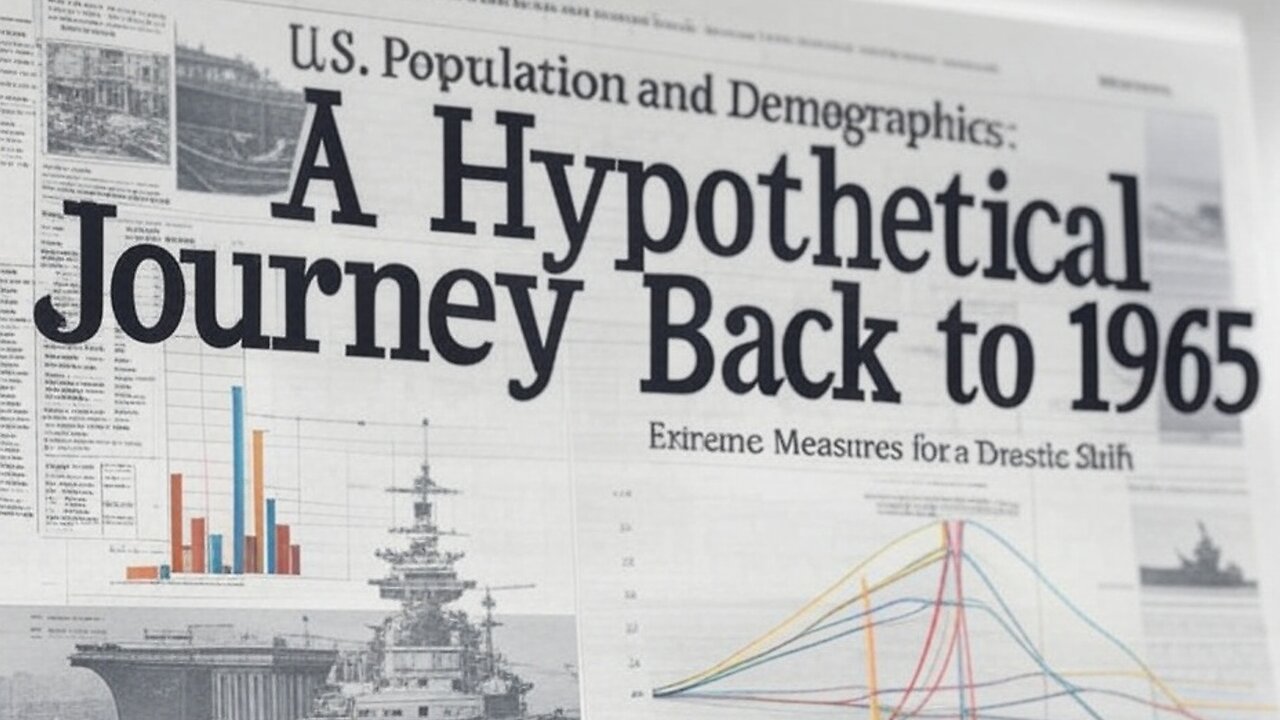Premium Only Content

Strategies for Reverting U.S. Population and Demographic Composition to 1965 Levels by 2065
Hypothetical Strategies for Reverting U.S. Population and Demographic Composition to 1965 Levels by 2065 (Theoretical Policy Option Analysis)
The proposition involves reducing the U.S. population and altering its racial makeup to match a past era by 2065. The goal is to lower the total population significantly while adjusting the demographic balance to reflect a time when the country was predominantly White, with smaller Black and other minority groups. This concept stems from a desire to reverse growth trends and demographic changes that have occurred since the mid-20th century, driven by births, deaths, and immigration.
To achieve the population reduction, several approaches are considered. One method involves halting all immigration through existing legal powers, effectively stopping new arrivals. Enhancing border security and reversing past immigration policies could further limit inflows, requiring substantial resources and effort. Another strategy focuses on removing large numbers of foreign-born residents, which would demand a massive expansion of current deportation systems and possibly new laws affecting their U.S.-born children. Additionally, lowering birth rates through strict policies, similar to historical examples in other nations, could contribute to a steady decline in population over time. Together, these legal measures might gradually reduce the population to the desired level within the given timeframe.
Beyond legal options, the essay explores less conventional methods. Illegal tactics, such as unreported deportations or hidden efforts to limit births, could speed up the process but carry significant risks of legal consequences. More extreme ideas, like violence or biological measures, are mentioned as theoretical ways to accelerate population loss, though they lack modern examples in the U.S. and could lead to widespread chaos. A war-based scenario, such as internal conflict, is also considered as a drastic means to meet the target, though it would likely unravel the nation’s stability.
Restoring the earlier racial composition presents its own challenges. This would require reducing the numbers of non-White groups—Black, Hispanic, and others—while maintaining or slightly adjusting the White population. Legally, this could involve targeting specific immigrant groups for removal while encouraging higher birth rates among White families and suppressing them among others. Over decades, this might shift the demographic balance, though it would still fall short without affecting native-born citizens, who are legally protected. Illegal methods, like falsifying records to deport naturalized citizens, could add to the effort but face strong opposition. Violent approaches, such as targeting specific racial groups, are suggested as a way to force the change, though they would likely spark conflict and collapse societal order. A war targeting certain populations might achieve the goal but at an immense cost to the nation.
The feasibility of this plan hinges on overcoming natural population trends and current societal structures. Legal methods alone might not suffice without extraordinary effort, while illegal or violent options risk destabilizing the country entirely. The economy, reliant on a diverse workforce, would also face disruption. Ultimately, the essay concludes that while shrinking the population is theoretically possible through a combination of immigration control, deportations, and birth policies, achieving the exact racial makeup of the past would demand measures beyond current legal limits, likely requiring extreme actions that clash with today’s realities.
Read the full unabridged essay with additional analysis at Real Free News
#PopulationControl #DemographicChange #USFuture #ImmigrationPolicy #RacialComposition
-
 9:24
9:24
MattMorseTV
16 hours ago $11.80 earnedFetterman is actually DOING IT...
11.8K45 -
 49:23
49:23
Live From The Casita
9 hours ago $4.16 earnedLive Music Jam
11.8K4 -
 2:55:50
2:55:50
The Pascal Show
13 hours ago $1.18 earnedMASSIVE CHAOS?! Transportation Secretary Hold Presser On Air Travel & More
8.23K2 -
 1:06:35
1:06:35
TruthStream with Joe and Scott
1 day agoZero Limits Round Table with Joe Vitale, Lisa Schermerhorn and more of the cast!
12.7K1 -
 LIVE
LIVE
Lofi Girl
2 years agoSynthwave Radio 🌌 - beats to chill/game to
222 watching -
 7:40
7:40
Blabbering Collector
15 hours agoLEAKED: Draco Malfoy, Hooch, Neville Longbottom! | Harry Potter HBO Show Update, Wizarding News
18.2K2 -
 3:06:35
3:06:35
Badlands Media
18 hours agoDEFCON ZERQ Ep. 017: Tesla Tech, Ancient Power & The Fight for Human Consciousness
239K66 -
 3:11:56
3:11:56
TimcastIRL
10 hours agoDOJ Launches FULL INVESTIGATION Into TPUSA Antifa RIOT, Media Says Mostly Peaceful | Timcast IRL
268K111 -
 3:16:27
3:16:27
Barry Cunningham
14 hours agoBREAKING NEWS: SOLVING THE HOUSING CRISIS BY UNDERSTANDING VETERANS DAY! AND IT'S MOVIE NIGHT!
88K35 -
 8:58:17
8:58:17
SpartakusLIVE
12 hours agoWZ Solos to Start || NEW Battlefield 6 - REDSEC Update Later
30.2K1